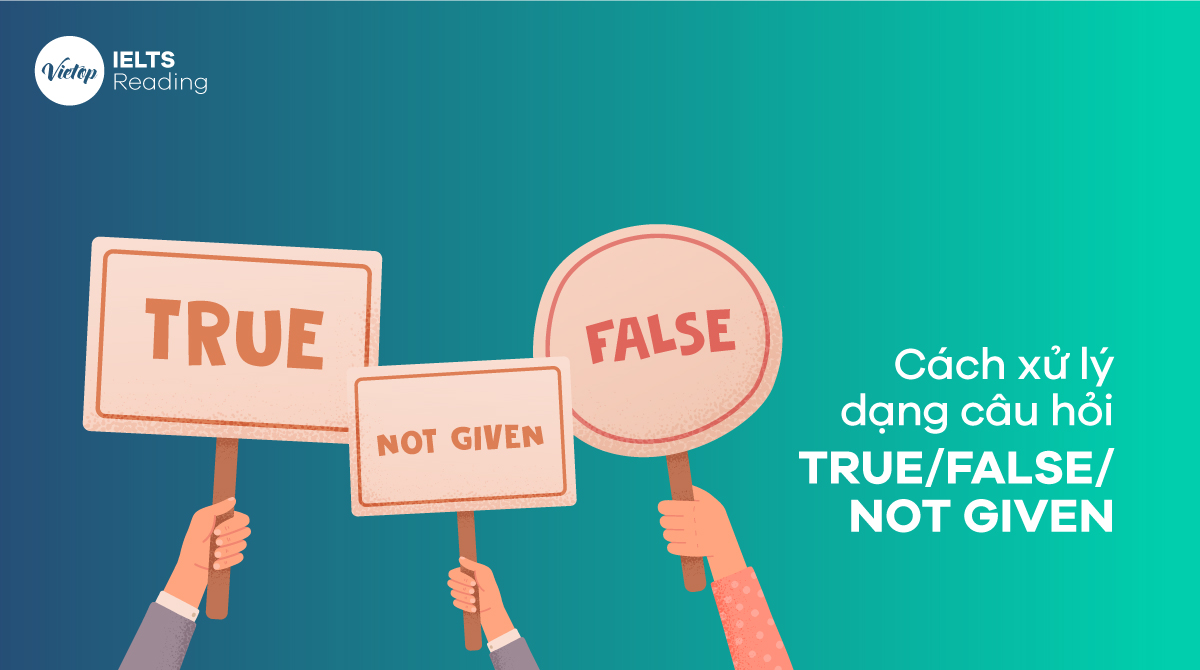Đối với các bạn đang luyện tập và chuẩn bị cho kỳ thi IELTS sắp tới, một trong những dạng bài quen thuộc nhưng khá khó đối phó chính là dạng bài True False Not Given. Dạng bài này thường bị nhầm lẫn với dạng bài Yes/ No/ Not Given và hay bị nhầm lẫn trong kết quả. Hãy cùng IELTS Vietop chinh phục dạng bài này trong bài viết dưới đây nhé!
Tổng quan về dạng bài True False Not Given trong IELTS
True False Not Given là một trong những dạng bài xuất hiện trong phần bài đọc của bài thi IELTS. Thường trong mỗi bài đọc sẽ xuất hiện một bài tập dạng True/False/Not Given với độ dài khoảng 5 – 7 câu. Dạng bài này đánh giá khả năng đọc hiểu của thí sinh.
Đề bài sẽ đưa ra các mệnh đề chứa nội dung liên quan đến bài đọc. Thí sinh sẽ phải đọc thông tin trong bài và đưa ra đáp án rằng mệnh đề đó đúng, sai hay không có thông tin.

Nhận tư vấn miễn phí khóa học hè
Phân biệt hai dạng bài True/False/Not Given và Yes/ No/ Not Given
Dạng bài True False Not Given thường hay bị nhầm với dạng bài Yes No Not Given. Hai dạng bài này khá giống nhau ở chỗ, đề bài sẽ đưa các mệnh đề, người đọc sẽ dựa vào nội dung bài đọc để điền đáp án T/F/NG hay Y/N/NG.
Dạng bài T/F/NG được đánh giá là dễ hơn. Với mệnh đề có nội dung trùng khớp với thông tin bài đọc đưa ra, sẽ được điền là True. Ngược lại, mệnh đề có nội dung hoàn toàn ngược lại với thông tin, ta sẽ có đáp án là False. Những mệnh đề được cho là Not Given thường sẽ có thông tin thiếu so với bài đọc.
Còn dạng bài Y/N/NG cần thí sinh có khả năng đọc hiểu tốt hơn và có sự tư duy. Với những mệnh đề được đưa ra, nếu có quan điểm đúng với quan điểm, ý nghĩa của bài đọc, tác giả thì đáp án là Yes, ngược lại là No. Đáp án Not Given tương tự trên, chứa thông tin không có trong bài đọc.
Chiến thuật làm dạng bài T/F/NG

Để phân tích chiến lược làm dạng bài True False Not Given, hãy cùng Vietop phân tích bài đọc sau đây:
The life and work of Marie Curie
Marie Curie is probably the most famous woman scientist who has ever lived. Born Maria Sklodowska in Poland in 1867, she is famous for her work on radioactivity, and was twice a winner of the Nobel Prize. With her husband, Pierre Curie, and Henri Becquerel, she was awarded the 1903 Nobel Prize for Physics, and was then sole winner of the 1911 Nobel Prize for Chemistry. She was the first woman to win a Nobel Prize.
From childhood, Marie was remarkable for her prodigious memory, and at the age of 16 won a gold medal on completion of her secondary education. Because her father lost his savings through bad investment, she then had to take work as a teacher. From her earnings she was able to finance her sister Bronia’s medical studies in Paris, on the understanding that Bronia would, in turn, later help her to get an education.
In 1891 this promise was fulfilled and Marie went to Paris and began to study at the Sorbonne (the University of Paris). She often worked far into the night and lived on little more than bread and butter and tea. She came first in the examination in the physical sciences in 1893, and in 1894 was placed second in the examination in mathematical sciences. It was not until the spring of that year that she was introduced to Pierre Curie.
Adapted with permission from Encyclopaedia Britannica, 2007 by Encyclopaedia Britannica, Inc.
- Marie Curie’s husband was a joint winner of both Marie’s Nobel Prizes.
- Marie became interested in science when she was a child.
- Marie was able to attend the Sorbonne because of her sister’s financial contribution.
Với đề bài như trên, chúng ta hãy cùng thực hiện các bước làm dạng bài này.
Bước 1: Gạch chân các keyword, ý chính của mệnh đề được cho. Hãy chú ý đến các danh từ chỉ người, chỉ vật, các từ chỉ địa điểm, thời gian, các động từ, tính từ chính và chú ý đến các từ mang nghĩa phủ định.
Như trong ví dụ trên, ta sẽ gạch chân các ý chính như sau:
- Marie Curie’s husband was a joint winner of both Marie’s Nobel Prizes.
- Marie became interested in science when she was a child.
- Marie was able to attend the Sorbonne because of her sister’s financial contribution.
Bước 2: Sau khi đã xác định từ khóa xong, hãy sử dụng kỹ năng scanning và skimming để tìm thông tin trong bài đọc. Xác định vị trí đoạn văn chứa thông tin cần thiết, chúng ta tiếp tục sử dụng kỹ năng đọc hiểu của mình để nắm bắt chính xác thông tin chứa trong đoạn văn đó.
Bước 3: Nếu bạn thấy rằng những thông tin trong bài trùng khớp với thông tin của mệnh đề, đáp án cần tím chính là True. Ngược lại, nếu bạn thấy những thông tin hay các từ ngữ có ý nghĩa trái ngược với mệnh đề, đáp án sẽ là False. Nếu thông tin được tìm thấy chỉ đúng một phần, hay thiếu thông tin, đáp án sẽ là Not Given.
Với ví dụ trên, ta có thể tìm thấy thông tin của mệnh đề thứ nhất ở đoạn:
“Marie Curie is probably the most famous woman scientist who has ever lived. Born Maria Sklodowska in Poland in 1867, she is famous for her work on radioactivity, and was twice a winner of the Nobel Prize. With her husband, Pierre Curie, and Henri Becquerel, she was awarded the 1903 Nobel Prize for Physics, and was then sole winner of the 1911 Nobel Prize for Chemistry. She was the first woman to win a Nobel Prize.”
Tuy nhiên, thông tin đưa ra lại sai với mệnh đề. Đoạn văn nói rằng Marie Curie nhận được 2 lần giải Nobel, còn chồng bà ấy thì chỉ được nhận một lần đồng giải. Vì vậy mệnh đề thứ nhất là False.
Cùng IELTS Vietop chinh phục dạng bài T/F/NG và Y/N/NG
Để chinh phục được dạng bài True False Not Given và dạng Yes No Not Given, điều quan trọng nhất chính là luyện tập. Bên cạnh việc rèn luyện các kỹ năng về đọc hiểu, cải thiện từ vựng, ngữ pháp, thì việc luyện tập thường xuyên sẽ giúp bạn tránh được các sai sót.
Một số lưu ý dành cho các bạn khi làm dạng bài này như sau:
- Hãy cẩn thận với những trạng từ chỉ tần suất (often, barely, always, sometimes), trạng từ xác suất (likely, probably), định lượng (some, many, a few), và động từ phương thức. Những từ, cụm từ này có thể thay đổi hoàn toàn ý nghĩa của câu hỏi khi so sánh với bài đọc.
- Thông tin trả lời cho các câu hỏi sẽ được xuất hiện theo thứ tự, bạn sẽ không mất quá nhiều thời gian khi tìm đáp án cho dạng bài này.
- Cố gắng đừng để mất quá nhiều thời gian cho một câu hỏi. Do đó, nếu bạn mất hơn 2 phút mà vẫn chưa tìm thấy thông tin cung cấp trong bài, hãy điền ‘Not Given’.
Bài tập
A SILENT FORCE

A. There is a legend that St Augustine in the fourth century AD was the first individual to be seen reading silently rather than aloud, or semi-aloud, as had been the practice hitherto. Reading has come a long way since Augustine’s day. There was a time when it was a menial job of scribes and priests, not the mark of civilization it became in Europe during the Renaissance when it was seen as one of the attributes of the civilized individual.
B. Modern nations are now seriously affected by their levels of literacy. While the Western world has seen a noticeable decline in these areas, other less developed countries have advanced and, in some cases, overtaken the West. India, for example, now has a large pool of educated workers. So European countries can no longer rest on their laurels as they have done for far too long; otherwise, they are in danger of falling even further behind economically.
C. It is difficult in the modern world to do anything other than a basic job without being able to read. Reading as a skill is the key to an educated workforce, which in turn is the bedrock of economic advancement, particularly in the present technological age. Studies have shown that by increasing the literacy and numeracy skills of primary school children in the UK, the benefit to the economy generally is in billions of pounds. The skill of reading is now no more just an intellectual or leisure activity, but rather a fully-fledged economic force.
D. Part of the problem with reading is that it is a skill which is not appreciated in most developed societies. This is an attitude that has condemned large swathes of the population in most Western nations to illiteracy. It might surprise people in countries outside the West to learn that in the United Kingdom, and indeed in some other European countries, the literacy rate has fallen to below that of so-called less developed countries.
E. There are also forces conspiring against reading in our modern society. It is not seen as cool among a younger generation more at home with computer screens or a Walkman. The solitude of reading is not very appealing. Students at school, college or university who read a lot are called bookworms. The term indicates the contempt in which reading and learning are held in certain circles or subcultures. It is a criticism, like all such attacks, driven by the insecurity of those who are not literate or are semi-literate. Criticism is also a means, like all bullying, of keeping peers in place so that they do not step out of line. Peer pressure among young people is so powerful that it often kills any attempts to change attitudes to habits like reading.
F. But the negative connotations apart, is modern Western society standing Canute-like against an uncontrollable spiral of decline? I think not.
G. How should people be encouraged to read more? It can easily be done by increasing basic reading skills at an early age and encouraging young people to borrow books from schools. Some schools have classroom libraries as well as school libraries. It is no good waiting until pupils are in their secondary school to encourage an interest in books; it needs to be pushed at an early age. Reading comics, magazines and low brow publications like Mills and Boon is frowned upon. But surely what people, whether they be adults or children, read is of little import. What is significant is the fact that they are reading. Someone who reads a comic today may have the courage to pick up a more substantial tome later on.
H. But perhaps the best idea would be to stop the negative attitudes to reading from forming in the first place. Taking children to local libraries brings them into contact with an environment where they can become relaxed among books. If primary school children were also taken in groups into bookshops, this might also entice them to want their own books. A local bookshop, like some local libraries, could perhaps arrange book readings for children which, being away from the classroom, would make the reading activity more of an adventure. On a more general note, most countries have writers of national importance. By increasing the standing of national writers in the eyes of the public, through local and national writing competitions, people would be drawn more to the printed word. Catch them young and, perhaps, they just might then all become bookworms.
Đọc lướt (Skim) thật nhanh qua từng đoạn (đọc lướt cả đoạn nếu gặp đoạn ngắn / chỉ đọc phần đầu & phần cuối nếu gặp đoạn dài), ta có tóm tắt như sau:
- Reading: St Augustine => the Renaissance
- Literacy affects the West (economically)
- Reading: a fully-fledged economic force
- Reading: not appreciated (in most developed societies)
- Reading: not cool / not appealing => bookworms
- The West: standing Canute-like? No
- Reading: how to encourage?
- The best idea: stop negative attitudes
Xem thêm: Mẹo làm bài Matching Headings trong IELTS Reading giúp bạn đạt điểm cao
Questions 23-27
Do the following statements agree with the information given in the Reading Passage?
In boxes 23-27 on your answer sheet, write
YES if the statement agrees with the writer’s claims
NO if the statement contradicts the writer’s claims
NOT GIVEN if there is no information about the statement
| Example: According to legend, St Augustine was the first person to be seen reading silently. Answer: YES |
23. European countries have been satisfied with past achievements for too long and have allowed other countries to overtake them in certain areas.
24. Reading is an economic force.
25. The literacy rate in less developed nations is considerably higher than in all European countries.
26. If you encourage children to read when they are young the negative attitude to reading that grows in some subcultures will be eliminated.
27. People should be discouraged from reading comics and magazines.
Bước đọc lướt & tóm tắt từng đoạn ngay từ đầu giúp ta định vị từng mẫu thông tin nhanh hơn
23. Paragraph B => Y
24. Paragraph C => Y
25. Paragraph D => NG (vì không có thông tin “considerably higher” & “all European countries”)
26. Paragraphs G & H => Y
27. Paragraph G => N
Bài giải
Đọc lướt (Skim) thật nhanh qua từng đoạn (đọc lướt cả đoạn nếu gặp đoạn ngắn / chỉ đọc phần đầu & phần cuối nếu gặp đoạn dài), ta có tóm tắt như sau:
- Đoạn A: Key words: “St Augustine”, “the first individual to be seen reading silently”, “menial job”, “attributes of the civilized individual”, “Renaissance” → vai trò của việc đọc thành tiếng từ thời phục hưng.
- Đoạn B: Key words: “nations,” “levels of literacy”, “less developed countries”, “educated workers”, “overtaken the West”; → thực trạng về giáo dục ở các nước.
- Đoạn C: Key words: “Reading”, “the key”, “educated workforce”; “increasing the literacy”, “the benefit to the economy”, “fully-fledged economic force” → Việc tăng khả năng đọc viết của người dân sẽ đem lại lợi ích về mặt kinh tế cho đất nước.
- Đoạn D: Key words: “not appreciated”, “European countries”, “the literacy rate has fallen” → thực trạng các nước phát triển không chú trọng tới khả năng đọc viết.
- Đoạn E: Key words: “not very appealing”, “bookworms”, “criticism”, “peer pressure”, “change attitudes” → Việc đọc sách bị xem là một điều kì lạ và bị dè bỉu ở các nước phát triển.
- Đoạn F: Key words: “Western society”, “standing Canute-like” → Đặt vấn đề liệu các nước phát triển có “làm ngơ” trước sự suy yếu về mặt giáo dục này hay không.
- Đoạn G: Key words: “encouraged to read”,”classroom libraries”, “libraries”, “at an early age” → Khuyến khích người dân có thói quen đọc sách.
- Đoạn H: Key word: “stop the negative attitudes” → đầu tiên nên thay đổi tư tưởng về việc đọc sách.
Xem thêm: Mẹo làm bài Matching Headings trong IELTS Reading giúp bạn đạt điểm cao
Sau khi đã tóm tắt được ý chính của toàn bài, ta sẽ có cái nhìn tổng quát về từng vấn đề được đề cập tới (vấn đề nào nằm ở đoạn nào) nên việc giải quyết câu hỏi sẽ dễ dàng và nhanh chóng hơn rất nhiều.
Cùng xem cách giải nhé!
- Câu 23 nhắc tới các nước phương tây so sánh với các nước kém phát triển hơn. Thông tin này nằm ở đoạn B; Cụ thể: “…other less developed countries have advanced and, in some cases, overtaken the West.” → Đáp án: YES.
- Câu hỏi 24 có key word “economic force”, có thể thấy ngay nội dung này được đề cập tới ở đoạn C; Cụ thể ở câu: “The skill of reading is now no more just an intellectual or leisure activity, but rather a fully-fledged economic force.” → Đáp án: YES.
- Câu 25 đề cập tới “literacy rate”, ta thấy có key word này ở đoạn D: “the literacy rate has fallen to below that of so-called less developed countries.”. Tuy nhiên câu hỏi lại viết “considerably higher” (cao hơn rất nhiều), thì trong đoạn D không đề cập tới mức độ chênh lệch của các nước là cao hay thấp → Đáp án: NOT GIVEN.
- Câu 26 có thể tìm được ở đoạn G: “It can easily be done by increasing basic reading skills at an early age…” → Đáp án: YES.
Câu 27 có thể tìm được ở đoạn G: “Reading comics, magazines and low brow publications […] What is significant is the fact that they are reading.” (không quan trọng là đọc gì, miễn là có đọc). → Đáp án: NO.
Chúc bạn thành công với IELTS Reading – Cách xử lý dạng câu hỏi TRUE/FALSE/NOT GIVEN nhé!











